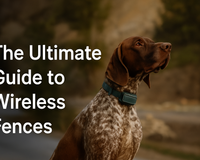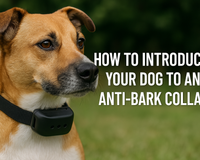We know how it feels when your dog escapes your backyard, your stomach drops in a pit of anxiety. And you’re wondering if your dog is safe, if they have harmed anything or if anything has harmed them, all whilst you're manically searching for them.
Remove that stress from your life by learning how to dog-proof a fence. We break down the different ways dogs can escape (and why) and go through the most popular dog proof fence options so that you can make an informed investment.
Different Ways Dogs Can Escape
Though every dog is unique, they are likely to escape in one of the following ways:
1. They climb over your fence
2. They dig under your fence
3. They jump over your fence
4. They push through or chew through your fence
5. They open a gate
Knowing which way your dog escapes allows you to address the escaping more effectively.
Why Dogs Try to Escape
There are so many reasons a dog may decide to become an escape artist.
They may be lonely and want the company of you or a friend. A territorial dog may see something they think threatens their home, and they want to go ward it off.
Some dogs see things like food, water, other dogs or other humans and think it's a new friend who wants to play. Others may simply need more outlets for their energy.
Each dog is different; some love to take a run up and jump over your fence; others love to dig under your fence. Some want to escape because they are anxious to be separated from you. Brilliant dogs figure out how to open a gate latch and leave no evidence.
There are many reasons why your dog is escaping. When you know how your dog escapes and can guess why they do, your dog proofing efforts will be more valuable.

Fence Free Solutions
We want to explain four options you have to dog-proof your property without buying or updating an entire fence. Fences are expensive; listed are some cost-friendly options to try before resorting to investing more time and money into creating the ultimate dog proof fence.1. E-Fence
An e-fence is one of the most cost-effective and low effort solutions on the market. An e-fence is a system that works by having a wire make a loop around your property; this wire connects to a transmitter. This transmitter will emit a static shock stimulation or other correction to your dog via a dog collar whenever the dog tries to get too close to the boundary.
The wire can either be buried or lay around the perimeter of your property, just remember to not run it over with the lawnmower. These systems are straightforward to use and set up, and your dog is corrected every time it tries to go too close to your fence.
By using a training tool like this that implements a correction within 1-2 seconds after the negative behaviour (like digging to the neighbours), your dog will learn what is and isn't acceptable.
Instant behaviour correction is much more effective than telling your dog off for escaping 3 hours after the fact. Your dog will correctly associate an action with a consequence.
Our best selling e-fence is the Advanced Hidden Fence System, this system is easy to use, efficient, and a cost-effective way to set a boundary without having to alter your fence.
2. Outdoor Kennel
Why not try to build an outdoor kennel? Outdoor kennel kits are easy to assemble and are an effective way to keep your dog in your property.
If your dog is a jumper or climber, this is a perfect solution. However, if your dog is a digger, you may need to fortify the foundations with some chicken wire so they cannot escape.
These work best for dogs who don’t like to wander around the backyard much, it’s also worth moving them frequently, so you don’t kill the same patch of lawn. Medium to extra large dogs may find the space to be too small, but you could always customise your kit to make it larger.
3. Leash Stake
A leash stake is a coiled length of metal (like a corkscrew) that screws into the ground. Your dog connects to the screw via a rope or leash. Determined escape artists may try to chew their way through the cord or leash.
These are better used whilst you can supervise your dog, and it won’t stop your dog from seeing other people or animals.
4. Build a Dog Run
A dog run is a cable or wire that is suspended a few feet above the ground, and your dog's leash clips to a sliding pulley on it, so your dog can run the length of the cable and their leash.
A dog run gives your pet a lot of space to move in your backyard, but they are not the easiest thing to install. Plus your dog will be running over the same areas of your property; they may wear out patches of your lawn.
Creating a dog run is a good solution if you like a good DIY, but you can buy ready to use kits. This option depends on your backyard and whether it is suitable for a dog run.
Considerations When Choosing a Fence
There are only a few types of fences on the market that will work the best for dog containment.1. Chain-Link Fences
Though not the most aesthetically pleasing, these fences are made of a series of steel poles and galvanised steel wire.
You can get chain-link fences in options that are up to 12 feet tall, but you’ll need to check with your council if you can install a structure that high in your area.
This is an affordable and durable option for those with large properties, or those who don’t mind the limited privacy they offer.
It is worth noting that some dogs can climb these fences, so taller versions will be more secure. The most determined of escape artists may try to chew their way through the wire; however, this isn’t that common.
2. Solid Fences
These fences are made of wood, steel, vinyl, PVC or other materials, and they usually are not see-through in any way.
Solid fences are generally 6 feet tall and are not as easy to climb as a chain-link fence. They are too tall for most dogs to jump over, but if your dog is an Olympic level jumper, then they may not be 100% effective.
Having a solid fence is an excellent option for those whose dog gets excited when they see a stimulus on the other side of the fence. Limiting this visual stimulation will stop them from trying to escape to make a new friend or ward off a potential enemy.
Because there are no gaps in these fences, their corners and joints are usually more secure than other fences (e.g. picket, wide gap metal fences etc.).
3. Brick or Concrete Fences
These fences are closer to walls, but with different intricate designs and materials, they can be defined as a fence. The bricks used can range from the standard red brick to concrete blocks.
Dogs can’t climb brick fences, and if you build one yourself, you can ensure it goes deep enough that your dog can’t dig under it.
The major downside to these fences is that they are expensive. They also require expertise to build, which adds to the cost.

How to Build a Dog Proof Fence
There are things you can build or add to your existing fence to dog proof it.Jumpers & Climbers
If your dog is a jumper or a climber, installing rollers at the top of your fence is an effective solution. Rollers are a piece of strong wire that goes through a PVC pipe; these wired pipes are mounted on top of your fence to hold them in place and maintain tension.
When your dog tries to climb or jump and puts their paws on the roller, it will spin towards them, and they won’t be able to get a good grip.
Diggers
If your dog is a digger, then you have some work ahead of you. You can put gravel along your fence line, which may deter your dog.
An effective solution will be to install a fence that extends below ground level (anywhere from 12-24 inches) so your dog won’t even be able to dig under your fence. This requires you to become the digger and dig a trench along your fence, which is labour-intensive.
It is one of the most effective ways to stop your dog from digging their way to freedom, but it will incur a materials cost and extensive labour.
Battery Rams
For those who have a dog that uses its own body as a battery ram to bust through a fence will need to think about materials.
Make sure your fence is made out of super durable materials such as wrought iron, brick or sealed hardwood. This should stop your dog from escaping.
Gate Openers
For those with ultra crafty dogs, try adding a durable padlock or dog proof clip to your gate. Also try putting a brick or other weight on the other side of the gate, even if they manage to open the lock, they won’t be able to push it open.
Browse our range of practical, dog proof e-fence systems. We have a variety of e-fence systems to suit your every need.







